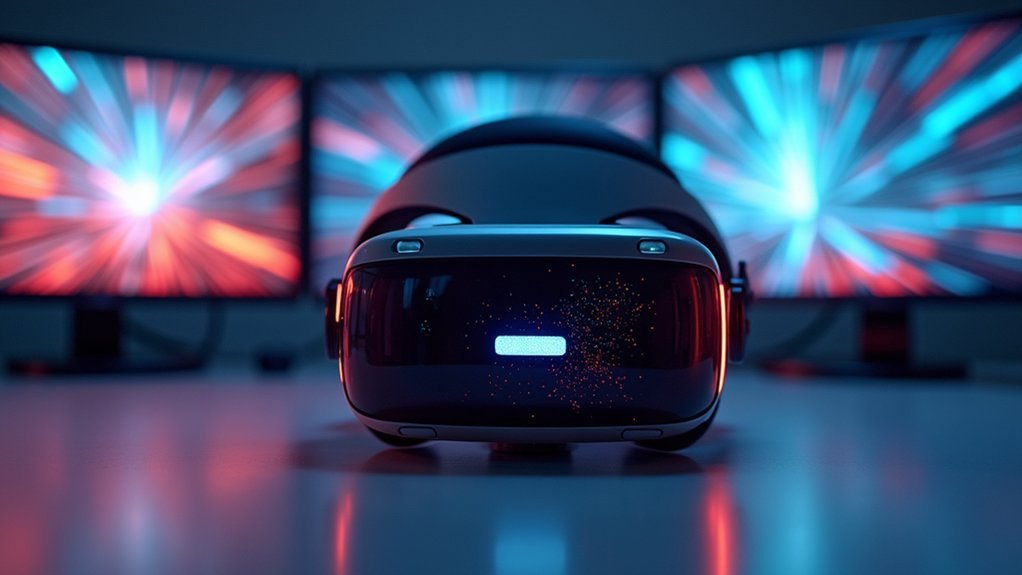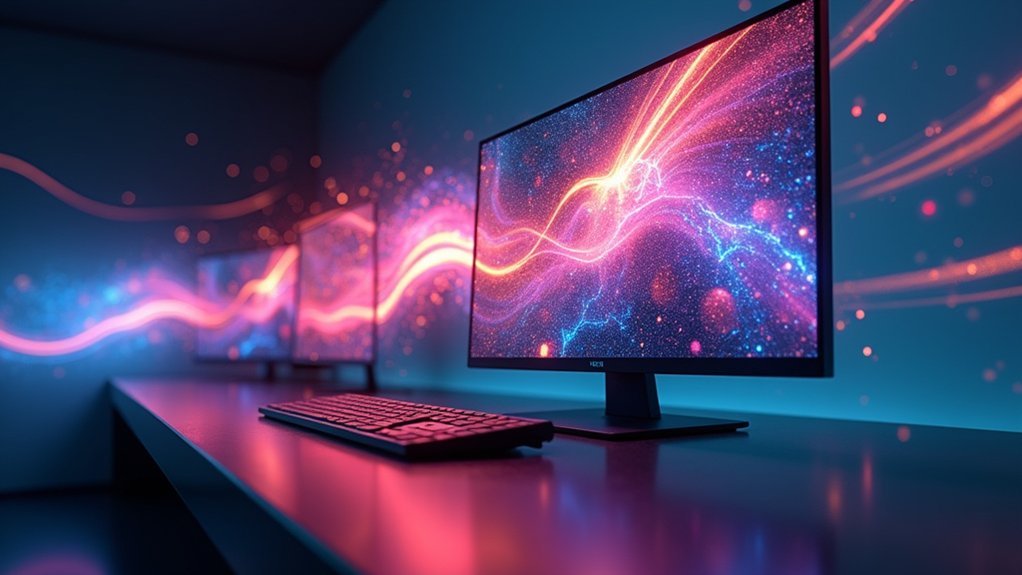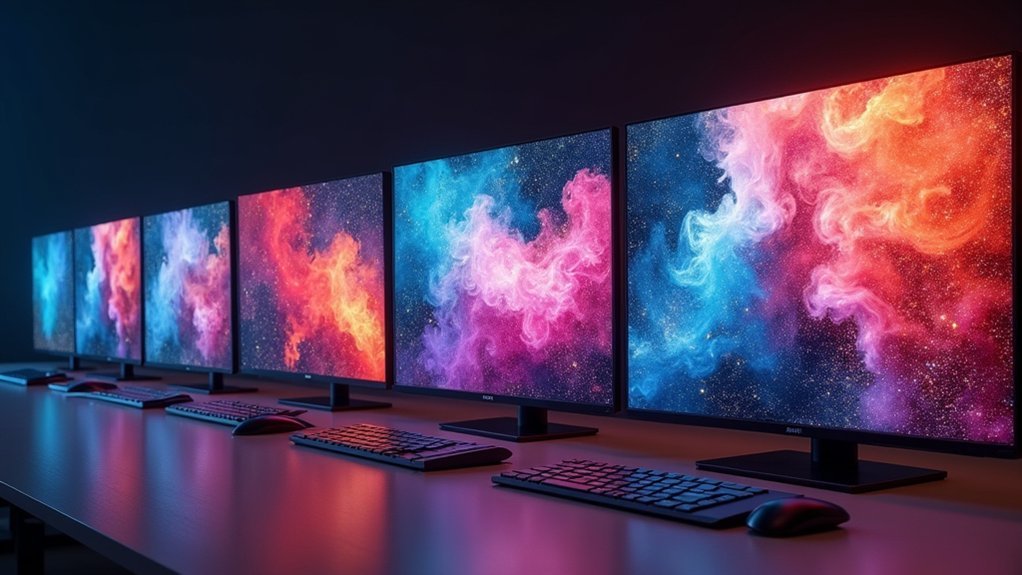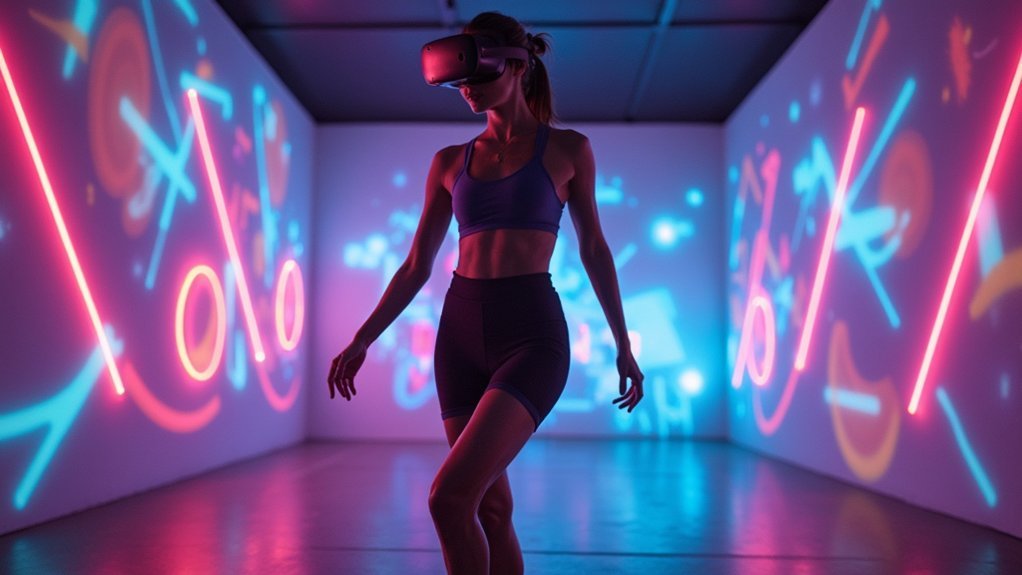You’ll find ideal VR display-to-render resolution ratios ranging from 1.2:1 to 1.8:1, where your headset renders content at higher resolutions than native display capabilities. Entry-level devices perform well at 1.2:1 ratios with 1080p displays, while mid-range headsets benefit from 1.4:1 ratios at 1440p resolution. Premium systems like Varjo XR-3 achieve exceptional clarity with 1.8:1 ratios at 4K per-eye resolution. Higher ratios enhance visual fidelity through supersampling but require more processing power. The following thorough analysis reveals advanced optimization techniques.
Understanding Rendering Pipeline Performance in VR Headsets

When you’re developing VR applications, the rendering pipeline’s performance becomes critical because higher display resolutions demand greatly more processing power to maintain the essential 90 FPS target that prevents motion sickness.
You’ll find that VR headsets utilize lower pixel density compared to traditional displays, yet they’re increasingly adopting 4K resolutions to eliminate the screen door effect and enhance visual clarity.
Your rendering pipeline must accommodate unique aspect ratio requirements, often 16:9 or wider formats, which differ notably from conventional displays.
VR displays require specialized aspect ratios beyond traditional 16:9 formats, demanding careful pipeline adjustments for optimal rendering performance.
You can optimize performance through techniques like foveated rendering, which dynamically scales resolution based on your user’s gaze focus. This approach lets you maintain visual fidelity while managing the computational demands of higher resolutions effectively.
Native Display Resolution Standards for Modern VR Devices
You’ll find that modern VR headsets operate with native resolutions ranging from 1080×1200 to 2160×2160 per eye, with each eye receiving its own dedicated display output for proper stereoscopic rendering.
Your headset’s refresh rate typically runs between 90Hz and 120Hz, ensuring smooth motion tracking and reducing the motion sickness that can occur with lower frame rates.
These eye-per-display specifications directly impact your visual experience, as higher pixel densities around 600 PPI help eliminate the screen door effect that can break immersion.
VR Headset Resolutions
Modern VR headsets pack impressive display technology that directly impacts your immersive experience, with native resolutions spanning from 1080×1200 on entry-level devices to an astounding 4320×2160 on premium models.
High-end headsets like the Varjo XR-3 deliver exceptional image quality through their 3840×2160 per-eye resolution, creating incredibly detailed visuals.
You’ll find most VR displays use 16:9 or 16:10 aspect ratios, optimizing your field of view for maximum immersion.
The pixels per inch density becomes vital here – manufacturers target at least 600 PPI to eliminate the distracting screen-door effect.
High resolution displays paired with 90-120Hz refresh rates guarantee smooth motion without motion sickness.
Premium headsets incorporate OLED or mini-LED technology, delivering deeper blacks and superior contrast ratios that enhance virtual environment realism.
Eye-Per-Display Specifications
Each eye in contemporary VR headsets receives its own dedicated display panel, with native resolutions starting at 1080p (1920 x 1080) and scaling up to 4K (3840 x 2160) per eye in flagship models.
You’ll find that screen resolution directly impacts your visual experience, with higher image resolution reducing pixelation and enhancing immersion.
Modern VR specifications follow these key standards:
- Resolution tiers – Entry-level devices offer 1080p per eye, mid-range models provide 1440p, while premium headsets deliver 4K per eye.
- Aspect ratio configurations – Most devices use 16:9 ratios, though some employ wider 21:9 formats for expanded field of view.
- Pixels per inch density – Leading headsets achieve 600+ PPI to eliminate screen door effects.
Higher resolution demands more processing power, so you’ll need to balance visual quality with your system’s capabilities for peak performance.
Refresh Rate Standards
Three critical refresh rate tiers define today’s VR landscape: 90Hz serves as the baseline standard, 120Hz represents the current sweet spot for premium devices, and 144Hz pushes the boundaries for enthusiast-grade headsets.
You’ll find that higher refresh rates dramatically reduce motion blur and latency, creating smoother visual experiences that complement your headset’s native resolution capabilities.
When you’re choosing a VR device, consider how refresh rate impacts your visual comfort. A 90Hz display paired with 2160×1200 resolution delivers solid performance, while 120Hz systems enhance responsiveness without compromising pixel density.
Premium headsets operating at 144Hz can handle higher resolution content more effectively, ensuring that increased pixel counts don’t sacrifice smooth motion. Your refresh rate choice should align with your native resolution requirements and performance expectations.
Supersampling Techniques and Their Impact on Visual Clarity
When you’re seeking the sharpest possible image quality from your display, supersampling techniques offer a powerful solution that renders graphics at resolutions far beyond your screen’s native capabilities before intelligently downscaling the result.
This process dramatically enhances visual clarity by eliminating jagged edges and improving texture detail.
You’ll encounter several supersampling approaches:
- 4xSSAA (4x Super Sampling Anti-Aliasing) – Renders images at four times your display’s resolution for maximum quality enhancement
- Temporal Supersampling (TAA) – Uses data from previous frames to maintain performance while delivering improved anti-aliasing
- Adaptive techniques – Adjust supersampling intensity based on scene complexity to balance quality and frame rates
However, you’ll need robust hardware since supersampling demands significant processing power and memory, potentially reducing performance if your system can’t handle the increased workload.
Eye Tracking Technology and Dynamic Resolution Scaling
While supersampling enhances image quality through brute computational force, eye tracking technology takes a smarter approach by monitoring where you’re actually looking and dynamically adjusting resolution accordingly. This innovative method uses cameras and sensors to track your eye movement in real-time, enabling dynamic resolution scaling that prioritizes pixel count where you need it most.
| Benefit | Traditional Rendering | Eye Tracking |
|---|---|---|
| Performance | Fixed resource allocation | Optimized distribution |
| Image Quality | Uniform across display | Enhanced in focal areas |
| Frame Rate | Limited by full resolution | Increased through scaling |
| Input Lag | Higher due to rendering load | Reduced peripheral processing |
Eye tracking technology delivers significant performance improvements by reducing rendering load in peripheral vision areas while maintaining superior image quality exactly where you’re focused.
Foveated Rendering Applications in High-End VR Systems
As VR technology pushes toward photorealistic experiences, foveated rendering has emerged as a game-changing solution that transforms how high-end systems deliver immersive visuals.
You’ll find this technique strategically reduces resolution in your peripheral vision while maintaining crisp pixels where you’re directly looking.
High-end VR platforms leverage eye-tracking to enhance your experience through:
- Dynamic pixel allocation – Real-time adjustment of rendering quality based on your gaze direction
- Performance scaling – Up to 50% reduction in computational load without sacrificing visual quality
- Hardware efficiency – Enhanced frame rates even on systems with limited processing power
Major platforms like Oculus and HTC Vive now integrate foveated rendering as standard technology.
This innovation allows you to experience photorealistic visuals while your VR system intelligently manages rendering resources for ideal performance.
Motion-to-Photon Latency Optimization Through Resolution Management

Since every millisecond counts in delivering seamless visual experiences, motion-to-photon latency enhancement has become critical for developers seeking responsive display performance.
You’ll find that higher resolution displays demand more processing power, potentially increasing delays between your actions and screen updates. To enhance performance, you can reduce render resolution—switching from 4K to 1080p considerably decreases processing time while maintaining acceptable visual quality.
Variable resolution scaling offers dynamic adjustment based on scene complexity, automatically lowering resolution during intensive sequences to minimize motion-to-photon latency.
You should regularly monitor frame rates alongside latency metrics when configuring resolution settings. This approach helps you balance visual fidelity with responsiveness, ensuring ideal motion clarity in demanding applications like gaming and VR.
Per-Eye Resolution Distribution for Immersive VR Experiences
When designing VR experiences that truly immerse users, you’ll discover that per-eye resolution distribution becomes the foundation of visual authenticity. Your per-eye resolution directly impacts clarity and comfort, with 1080p serving as the bare minimum to prevent motion sickness. However, you’ll want to target higher standards for ideal results.
Consider these essential per-eye resolution benchmarks:
- 1440p (2560 x 1440) – High-end VR standard that greatly reduces the screen door effect
- 1440 x 1600 – Premium resolution used by leading headsets like the Valve Index
- Combined 4K-8K total – Achieves exceptional detail when both eyes work together
Your aspect ratio choices must account for each eye’s independent display requirements. Higher pixel density minimizes visual artifacts while maintaining proper aspect ratio distribution across wider fields of view, ensuring seamless immersion.
Frequently Asked Questions
What Is the Best Resolution Ratio for Display?
You’ll find 16:9 offers the best resolution ratio for most displays, providing ideal balance for HD content. For cinematic experiences, you’d prefer 21:9, while professional work benefits from higher resolutions like QHD or 4K.
Is It Better to Use 4:3 or 16:9?
You’ll find 16:9 better for modern use since it’s optimized for HD content, gaming, and movies. However, you’d prefer 4:3 for presentations or specific photography where square formats work better.
Should I Use 16:9 or 21:9?
You should choose 16:9 if you’re primarily consuming standard media content, but opt for 21:9 if you’re gaming frequently or need extra horizontal workspace for productivity tasks.
Should I Use 16/9 or 16/10?
You’ll want 16:9 if you’re primarily watching videos or gaming since it matches standard displays. Choose 16:10 if you’re doing productivity work, document editing, or design tasks requiring extra vertical space.





Leave a Reply